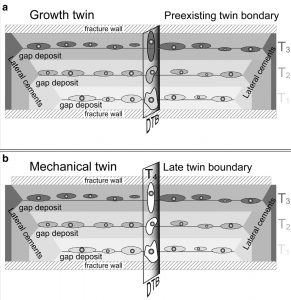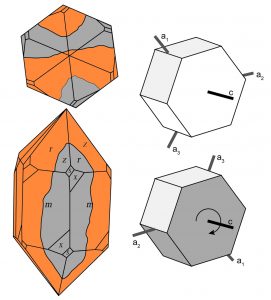Andras Fall, Esti Ukar and Steve Laubach recently reported on using combined scanning electron microscope-based cathodoluminescence (SEM-CL) and electron backscattered diffraction (EBSD) image analysis with fluid inclusion microthermometry to constrain the origin and timing of Dauphiné twins in quartz cement bridges.
Electron backscattered diffraction techniques (EBSD) show that Dauphiné twins in quartz are widespread in many tectonometamorphic environments. Our study documents that under diagenetic temperatures (less than 200°C) and burial depths less than 5 km Dauphiné twins are common in isolated fracture quartz deposits spanning between fracture walls (i.e., quartz bridges) in low-porosity quartz-cemented sandstones.

Twins and FIAd sandstones.
Using examples from East Texas and Colorado cores, Fall and others show that twins are associated with crack-seal microstructure and fluid inclusions. Fracture wall-parallel and wall-normal inclusion trails contain coexisting aqueous and hydrocarbon gas inclusions, so homogenization temperatures of aqueous inclusions record true trapping temperatures. Inclusions in alignments normal to fracture walls are large and irregularly shaped compared to those aligned parallel to walls, but both show similar liquid-to-vapor ratios.
Stacking transmitted light images with scanning electron microscope cathodoluminescence (SEM-CL) and EBSD images demonstrates that Dauphiné twin boundaries are localized along wall-normal inclusion trails. Trapping temperatures for wall-normal inclusion trails are usually higher than those aligned parallel to the fracture wall. Wall-normal fluid inclusion assemblage temperatures typically match the highest temperatures of wall-parallel assemblages trapped during sequential widening, but not necessarily the most recent.
In context of burial histories for these samples, this temperature pattern implies that wall-normal assemblages form at discrete times during or after crack-seal fracture widening.
Localization in

Twins
isolated, potentially high-stress quartz deposits in fractures is compatible with a mechanical origin for these Dauphiné twins. Punctuated temperature values and discrepant sizes and shapes of inclusions in wall-normal trails implies that twinning is a by-product of the formation of the wall-normal inclusion assemblages.
The association of Dauphiné twins and fluid inclusion assemblages from which temperature and possibly timing can be inferred provides a way to research timing as well as magnitude of paleostress in some diagenetic settings.
For more information:
Fall, A., Ukar, E., Laubach, S.E., 2016. Origin and timing of Dauphiné twins in quartz cement in fractured sandstones from diagenetic environments: insight from fluid inclusions. Tectonophysics 687, 195-209. doi.org/10.1016/j.tecto.2016.08.014 | view
© 2024 Jackson School of Geosciences, The University of Texas at Austin


